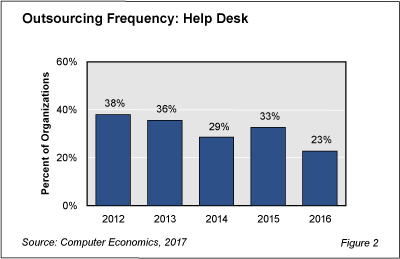The decision to turn over an organization’s IT help desk function to a service provider has a long history. Even so, our research shows that help desk outsourcing is not as common as one might think and continues to drop: Less than one quarter of IT organizations currently rely on service providers to perform help desk activities.
As shown in Figure 2 from our full report, IT Help Desk Outsourcing Trends and Customer Experience, the number of companies outsourcing help desk work dropped significantly in 2016, continuing a multiyear declining trend that coincides with the economic recovery period. Approximately 23% of organizations outsourced some help desk work in 2016.

The rise and subsequent fall in the outsourcing frequency of this function indicates that the recovery cycle is having a large influence. As IT organizations began hiring permanent employees, the help desk was one area where work was brought back in-house.
“The IT help desk seems like an easy thing to cut when times are tight,” said David Wagner, vice president for research at Computer Economics, an IT research firm based in Irvine, Calif. “But when times are good, there are many strategic reasons to keep it in-house. The IT help desk is often the face of an IT department, as it is the only source of contact some users will have with the department. It is often the place where young IT engineers cut their teeth before moving on to high-level jobs in the organization.”
Overall, the study finds, the outsourcing of the help desk function is low compared to the outsourcing of other IT functions. Many organizations keep all help desk functions in-house to ensure the quality of end-user support. IT organizations also seek to leverage the help desk as a primary point of contact between users and the IT organization. The help desk can perform related functions such as asset management, training, monitoring user satisfaction, and monitoring the organization’s IT systems.
However, the help desk is a people-intensive operation, often comprising 9% or more of the typical IT staff. It also is a process-intensive operation that benefits from investments in software and automated systems. As such, smaller IT organizations can find outsourcing this function a quick way to reduce costs while gaining access to the expertise and economies of scale of service providers.
IT executives should consider their help desk strategies in light of current trends. The full study measures help desk outsourcing activity through outsourcing frequency, level, volatility, net growth trend, cost experience, and service experience. It also compares help desk outsourcing frequency and level by organization size and sector.
This Research Byte is based on our report on this subject, Help Desk Outsourcing Trends and Customer Experience. The full report is available at no charge for Computer Economics clients, or it may be purchased by non-clients directly from our website (click for pricing).

